Impact of Domestic Violence on Mental Health: A Case Study
VerifiedAdded on 2023/06/14
|8
|2316
|135
AI Summary
This case study discusses the impact of domestic violence on mental health of victims and the effectiveness of social learning and attachment theory in protecting people from domestic violence. It also covers risk management, case formulation, intervention, and outcome.
Contribute Materials
Your contribution can guide someone’s learning journey. Share your
documents today.

Case Study
1
1
Secure Best Marks with AI Grader
Need help grading? Try our AI Grader for instant feedback on your assignments.
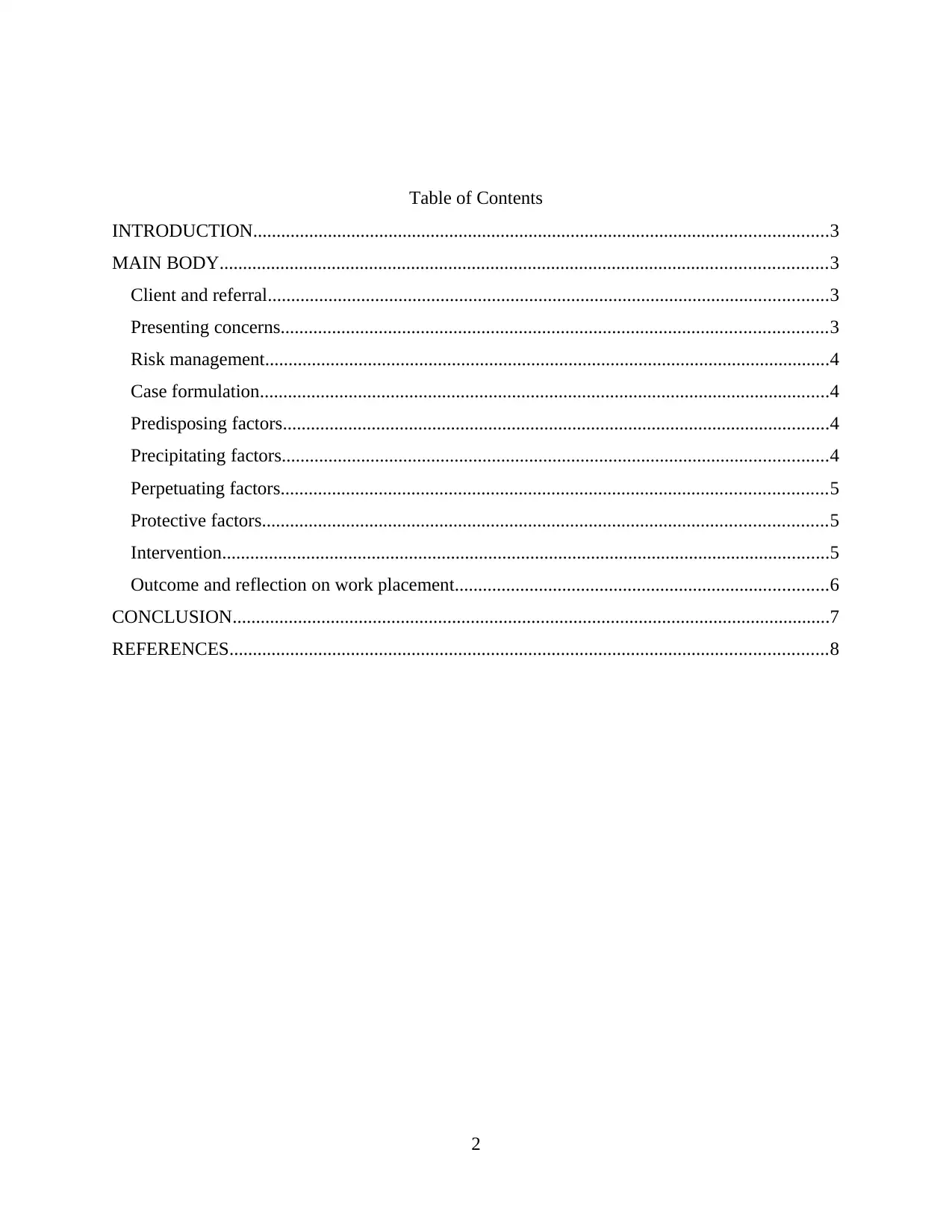
Table of Contents
INTRODUCTION...........................................................................................................................3
MAIN BODY..................................................................................................................................3
Client and referral........................................................................................................................3
Presenting concerns.....................................................................................................................3
Risk management.........................................................................................................................4
Case formulation..........................................................................................................................4
Predisposing factors.....................................................................................................................4
Precipitating factors.....................................................................................................................4
Perpetuating factors.....................................................................................................................5
Protective factors.........................................................................................................................5
Intervention..................................................................................................................................5
Outcome and reflection on work placement................................................................................6
CONCLUSION................................................................................................................................7
REFERENCES................................................................................................................................8
2
INTRODUCTION...........................................................................................................................3
MAIN BODY..................................................................................................................................3
Client and referral........................................................................................................................3
Presenting concerns.....................................................................................................................3
Risk management.........................................................................................................................4
Case formulation..........................................................................................................................4
Predisposing factors.....................................................................................................................4
Precipitating factors.....................................................................................................................4
Perpetuating factors.....................................................................................................................5
Protective factors.........................................................................................................................5
Intervention..................................................................................................................................5
Outcome and reflection on work placement................................................................................6
CONCLUSION................................................................................................................................7
REFERENCES................................................................................................................................8
2

INTRODUCTION
This study is based on a case in which a girl left her school when she was 14 years old
because of her father’s domestic violence and pressure of her mother on her. This study will
discuss impact of domestic violence on mental health of victims (Kofman and Garfin, 2020).
Further, it will discuss some causing factors of this and effectiveness of social learning and
attachment theory in protecting people from domestic violence.
MAIN BODY
Client and referral
This is the case of client who came from Portugal when she was 18 years old. After
communicating with her, it is found that she left school when she was 14 years old in Portugal.
The reason behind this was violence at home. Her father was violent to his wife or mother of this
client. Culturally, his wife or mother of the client was not able to speak or respond to her
partner’s violent behavior. But she put pressure or her frustration on her kids and it was the main
reason as client left school at the age of 14 only. She started going to work and there she fell in
love with the man, she came with him from Portugal. They have arrived to Australia and
currently she represented with domestic violence by her partner or husband (Sharma and Borah,
2020). It is found that her husband is the same as like her father as her partner is cheating on her
as her father did with her mother. Now she is suffering the same as like her mother and finds
herself unable to respond or speak about her husband in a detailed manner. The reason as she
cannot respond and speak is: her job of taking care of kids, looking after family, cooking and
cleaning home.
The reason of referring and presenting this client to care, provided by social worker is to
protect her and her kids from being affected negatively and mentally from domestic violence. It
is stated that when domestic violence is not being considered in a timely manner then it can
affect client mentally and physically. So, for protecting client from getting affected mentally, this
case was referred to social worker.
Presenting concerns
As on the basis of above client’s profile, it can clearly be said that client is suffering from
domestic violence. It can be worsen with the time if it is not being considered. It has been found
3
This study is based on a case in which a girl left her school when she was 14 years old
because of her father’s domestic violence and pressure of her mother on her. This study will
discuss impact of domestic violence on mental health of victims (Kofman and Garfin, 2020).
Further, it will discuss some causing factors of this and effectiveness of social learning and
attachment theory in protecting people from domestic violence.
MAIN BODY
Client and referral
This is the case of client who came from Portugal when she was 18 years old. After
communicating with her, it is found that she left school when she was 14 years old in Portugal.
The reason behind this was violence at home. Her father was violent to his wife or mother of this
client. Culturally, his wife or mother of the client was not able to speak or respond to her
partner’s violent behavior. But she put pressure or her frustration on her kids and it was the main
reason as client left school at the age of 14 only. She started going to work and there she fell in
love with the man, she came with him from Portugal. They have arrived to Australia and
currently she represented with domestic violence by her partner or husband (Sharma and Borah,
2020). It is found that her husband is the same as like her father as her partner is cheating on her
as her father did with her mother. Now she is suffering the same as like her mother and finds
herself unable to respond or speak about her husband in a detailed manner. The reason as she
cannot respond and speak is: her job of taking care of kids, looking after family, cooking and
cleaning home.
The reason of referring and presenting this client to care, provided by social worker is to
protect her and her kids from being affected negatively and mentally from domestic violence. It
is stated that when domestic violence is not being considered in a timely manner then it can
affect client mentally and physically. So, for protecting client from getting affected mentally, this
case was referred to social worker.
Presenting concerns
As on the basis of above client’s profile, it can clearly be said that client is suffering from
domestic violence. It can be worsen with the time if it is not being considered. It has been found
3
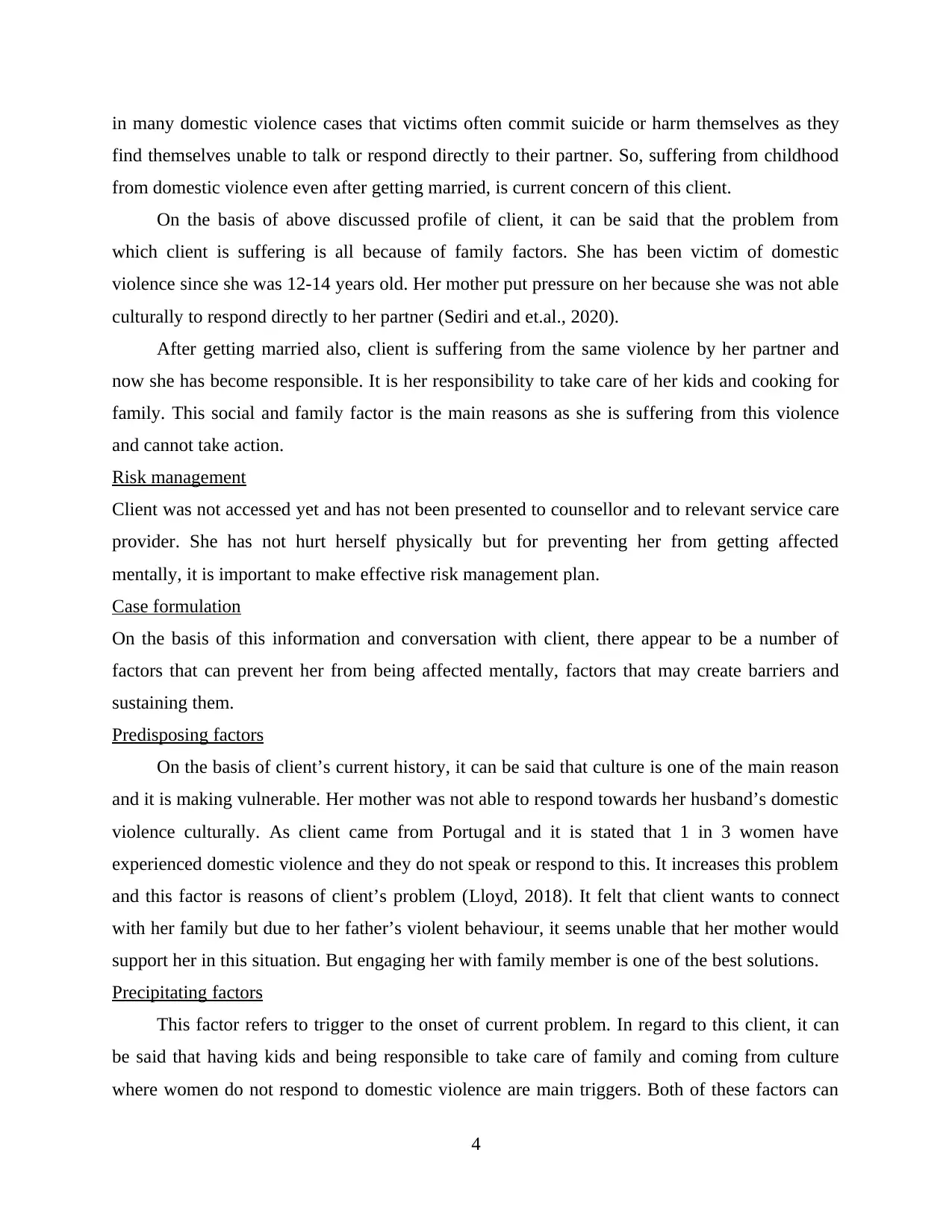
in many domestic violence cases that victims often commit suicide or harm themselves as they
find themselves unable to talk or respond directly to their partner. So, suffering from childhood
from domestic violence even after getting married, is current concern of this client.
On the basis of above discussed profile of client, it can be said that the problem from
which client is suffering is all because of family factors. She has been victim of domestic
violence since she was 12-14 years old. Her mother put pressure on her because she was not able
culturally to respond directly to her partner (Sediri and et.al., 2020).
After getting married also, client is suffering from the same violence by her partner and
now she has become responsible. It is her responsibility to take care of her kids and cooking for
family. This social and family factor is the main reasons as she is suffering from this violence
and cannot take action.
Risk management
Client was not accessed yet and has not been presented to counsellor and to relevant service care
provider. She has not hurt herself physically but for preventing her from getting affected
mentally, it is important to make effective risk management plan.
Case formulation
On the basis of this information and conversation with client, there appear to be a number of
factors that can prevent her from being affected mentally, factors that may create barriers and
sustaining them.
Predisposing factors
On the basis of client’s current history, it can be said that culture is one of the main reason
and it is making vulnerable. Her mother was not able to respond towards her husband’s domestic
violence culturally. As client came from Portugal and it is stated that 1 in 3 women have
experienced domestic violence and they do not speak or respond to this. It increases this problem
and this factor is reasons of client’s problem (Lloyd, 2018). It felt that client wants to connect
with her family but due to her father’s violent behaviour, it seems unable that her mother would
support her in this situation. But engaging her with family member is one of the best solutions.
Precipitating factors
This factor refers to trigger to the onset of current problem. In regard to this client, it can
be said that having kids and being responsible to take care of family and coming from culture
where women do not respond to domestic violence are main triggers. Both of these factors can
4
find themselves unable to talk or respond directly to their partner. So, suffering from childhood
from domestic violence even after getting married, is current concern of this client.
On the basis of above discussed profile of client, it can be said that the problem from
which client is suffering is all because of family factors. She has been victim of domestic
violence since she was 12-14 years old. Her mother put pressure on her because she was not able
culturally to respond directly to her partner (Sediri and et.al., 2020).
After getting married also, client is suffering from the same violence by her partner and
now she has become responsible. It is her responsibility to take care of her kids and cooking for
family. This social and family factor is the main reasons as she is suffering from this violence
and cannot take action.
Risk management
Client was not accessed yet and has not been presented to counsellor and to relevant service care
provider. She has not hurt herself physically but for preventing her from getting affected
mentally, it is important to make effective risk management plan.
Case formulation
On the basis of this information and conversation with client, there appear to be a number of
factors that can prevent her from being affected mentally, factors that may create barriers and
sustaining them.
Predisposing factors
On the basis of client’s current history, it can be said that culture is one of the main reason
and it is making vulnerable. Her mother was not able to respond towards her husband’s domestic
violence culturally. As client came from Portugal and it is stated that 1 in 3 women have
experienced domestic violence and they do not speak or respond to this. It increases this problem
and this factor is reasons of client’s problem (Lloyd, 2018). It felt that client wants to connect
with her family but due to her father’s violent behaviour, it seems unable that her mother would
support her in this situation. But engaging her with family member is one of the best solutions.
Precipitating factors
This factor refers to trigger to the onset of current problem. In regard to this client, it can
be said that having kids and being responsible to take care of family and coming from culture
where women do not respond to domestic violence are main triggers. Both of these factors can
4
Secure Best Marks with AI Grader
Need help grading? Try our AI Grader for instant feedback on your assignments.
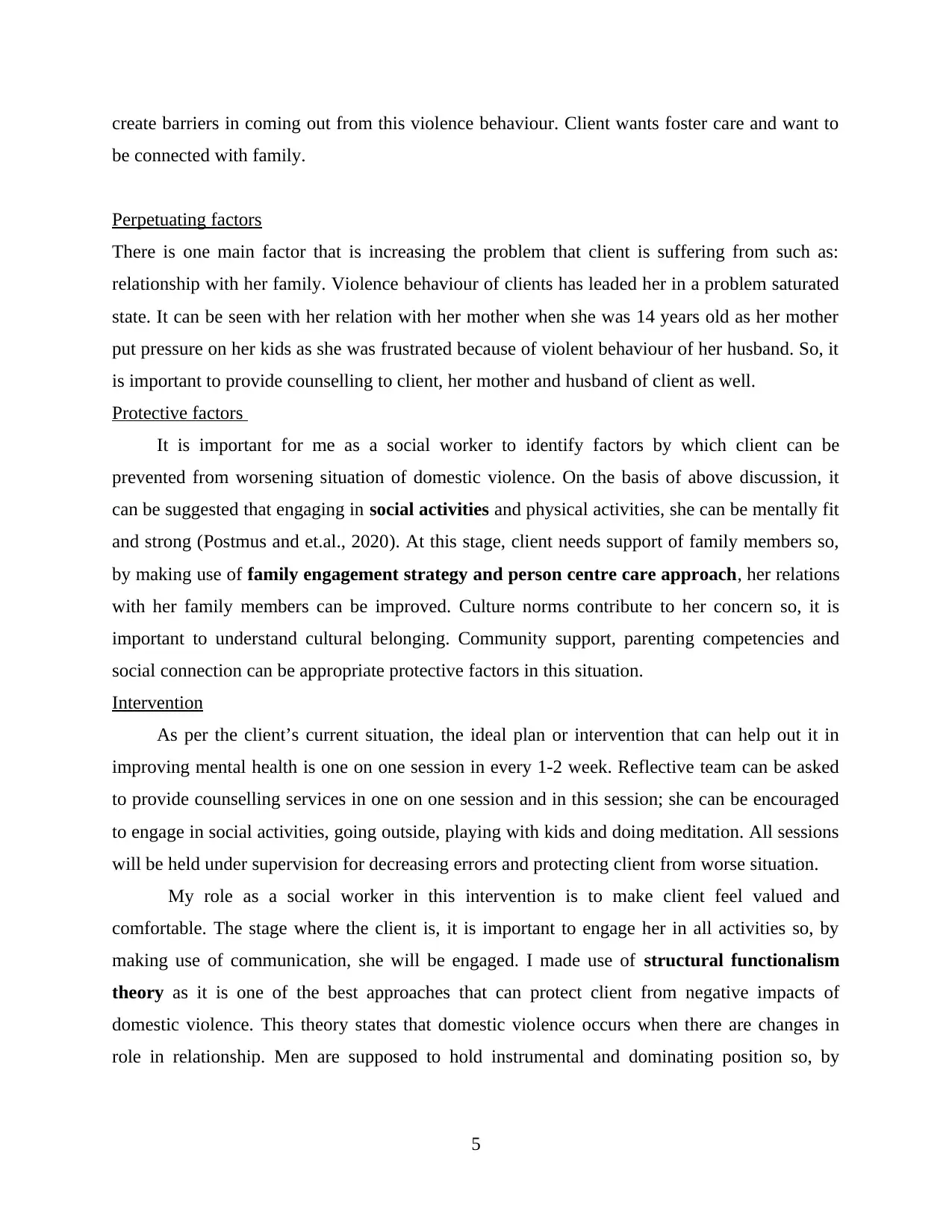
create barriers in coming out from this violence behaviour. Client wants foster care and want to
be connected with family.
Perpetuating factors
There is one main factor that is increasing the problem that client is suffering from such as:
relationship with her family. Violence behaviour of clients has leaded her in a problem saturated
state. It can be seen with her relation with her mother when she was 14 years old as her mother
put pressure on her kids as she was frustrated because of violent behaviour of her husband. So, it
is important to provide counselling to client, her mother and husband of client as well.
Protective factors
It is important for me as a social worker to identify factors by which client can be
prevented from worsening situation of domestic violence. On the basis of above discussion, it
can be suggested that engaging in social activities and physical activities, she can be mentally fit
and strong (Postmus and et.al., 2020). At this stage, client needs support of family members so,
by making use of family engagement strategy and person centre care approach, her relations
with her family members can be improved. Culture norms contribute to her concern so, it is
important to understand cultural belonging. Community support, parenting competencies and
social connection can be appropriate protective factors in this situation.
Intervention
As per the client’s current situation, the ideal plan or intervention that can help out it in
improving mental health is one on one session in every 1-2 week. Reflective team can be asked
to provide counselling services in one on one session and in this session; she can be encouraged
to engage in social activities, going outside, playing with kids and doing meditation. All sessions
will be held under supervision for decreasing errors and protecting client from worse situation.
My role as a social worker in this intervention is to make client feel valued and
comfortable. The stage where the client is, it is important to engage her in all activities so, by
making use of communication, she will be engaged. I made use of structural functionalism
theory as it is one of the best approaches that can protect client from negative impacts of
domestic violence. This theory states that domestic violence occurs when there are changes in
role in relationship. Men are supposed to hold instrumental and dominating position so, by
5
be connected with family.
Perpetuating factors
There is one main factor that is increasing the problem that client is suffering from such as:
relationship with her family. Violence behaviour of clients has leaded her in a problem saturated
state. It can be seen with her relation with her mother when she was 14 years old as her mother
put pressure on her kids as she was frustrated because of violent behaviour of her husband. So, it
is important to provide counselling to client, her mother and husband of client as well.
Protective factors
It is important for me as a social worker to identify factors by which client can be
prevented from worsening situation of domestic violence. On the basis of above discussion, it
can be suggested that engaging in social activities and physical activities, she can be mentally fit
and strong (Postmus and et.al., 2020). At this stage, client needs support of family members so,
by making use of family engagement strategy and person centre care approach, her relations
with her family members can be improved. Culture norms contribute to her concern so, it is
important to understand cultural belonging. Community support, parenting competencies and
social connection can be appropriate protective factors in this situation.
Intervention
As per the client’s current situation, the ideal plan or intervention that can help out it in
improving mental health is one on one session in every 1-2 week. Reflective team can be asked
to provide counselling services in one on one session and in this session; she can be encouraged
to engage in social activities, going outside, playing with kids and doing meditation. All sessions
will be held under supervision for decreasing errors and protecting client from worse situation.
My role as a social worker in this intervention is to make client feel valued and
comfortable. The stage where the client is, it is important to engage her in all activities so, by
making use of communication, she will be engaged. I made use of structural functionalism
theory as it is one of the best approaches that can protect client from negative impacts of
domestic violence. This theory states that domestic violence occurs when there are changes in
role in relationship. Men are supposed to hold instrumental and dominating position so, by
5

encouraging women to play equal roles and responding negative actions of men, they can protect
themselves.
On the basis of above discussion and client’s profile, it can be said that lower self-esteem
and family history of being abused at young age (Powers and et.al., 2020). So, on the basis of
this, it can be said that attachment theory, behavioural theory and social learning theory can be
suitable for this client.
Social learning is the most explanatory perspectives in the marital violence literature.
This theory states that children learn number of things from their surroundings and what they
see. In this case, it happened the same as client’s mother did not respond to her husband for
domestic violence so, this client also not responded. So, in this context, it can be suggested that
parents should be educated about ways of dealing with such situations and handling stress and
frustration so that they can teach their children to not accept such behaviour and improving their
mental health.
Attachment theory also believes that most of the things that people do is all because of
attachment. Clients’ behaviour can be understood with her attachment with things and people.
She does not want to be separated from her husband and wants to improve health of kids so she
did not respond to domestic violence and violent behaviour of her husband (Sutton, 2019). Social
changes are necessary as people need to understand the difference between the right and wrong
and by increasing this knowledge, this client can be protected from getting affected from
violence behaviour of her husband.
Outcome and reflection on work placement
As a social worker, I want to share my feelings and experience when I communicated and
deal with client. I found that domestic violence has negative impact on victims as it has negative
mental impact on people. There are number of things that worked well in this study for client
such as: social engagement. After monitoring, it found that she engaged in social activities.
Social learning theory helped out in understanding impact of society on behaviour of people.
Society and environment where we live, have great impact on our behaviour. So, on the basis of
this, I can say that we all need to understand the difference between the right and wrong and
performing each function in an ethical manner (Noonan and Pilkington, 2020). My ability to
work with others and communicational skill helped me out in engaging client in all counselling
sessions and social activities.
6
themselves.
On the basis of above discussion and client’s profile, it can be said that lower self-esteem
and family history of being abused at young age (Powers and et.al., 2020). So, on the basis of
this, it can be said that attachment theory, behavioural theory and social learning theory can be
suitable for this client.
Social learning is the most explanatory perspectives in the marital violence literature.
This theory states that children learn number of things from their surroundings and what they
see. In this case, it happened the same as client’s mother did not respond to her husband for
domestic violence so, this client also not responded. So, in this context, it can be suggested that
parents should be educated about ways of dealing with such situations and handling stress and
frustration so that they can teach their children to not accept such behaviour and improving their
mental health.
Attachment theory also believes that most of the things that people do is all because of
attachment. Clients’ behaviour can be understood with her attachment with things and people.
She does not want to be separated from her husband and wants to improve health of kids so she
did not respond to domestic violence and violent behaviour of her husband (Sutton, 2019). Social
changes are necessary as people need to understand the difference between the right and wrong
and by increasing this knowledge, this client can be protected from getting affected from
violence behaviour of her husband.
Outcome and reflection on work placement
As a social worker, I want to share my feelings and experience when I communicated and
deal with client. I found that domestic violence has negative impact on victims as it has negative
mental impact on people. There are number of things that worked well in this study for client
such as: social engagement. After monitoring, it found that she engaged in social activities.
Social learning theory helped out in understanding impact of society on behaviour of people.
Society and environment where we live, have great impact on our behaviour. So, on the basis of
this, I can say that we all need to understand the difference between the right and wrong and
performing each function in an ethical manner (Noonan and Pilkington, 2020). My ability to
work with others and communicational skill helped me out in engaging client in all counselling
sessions and social activities.
6
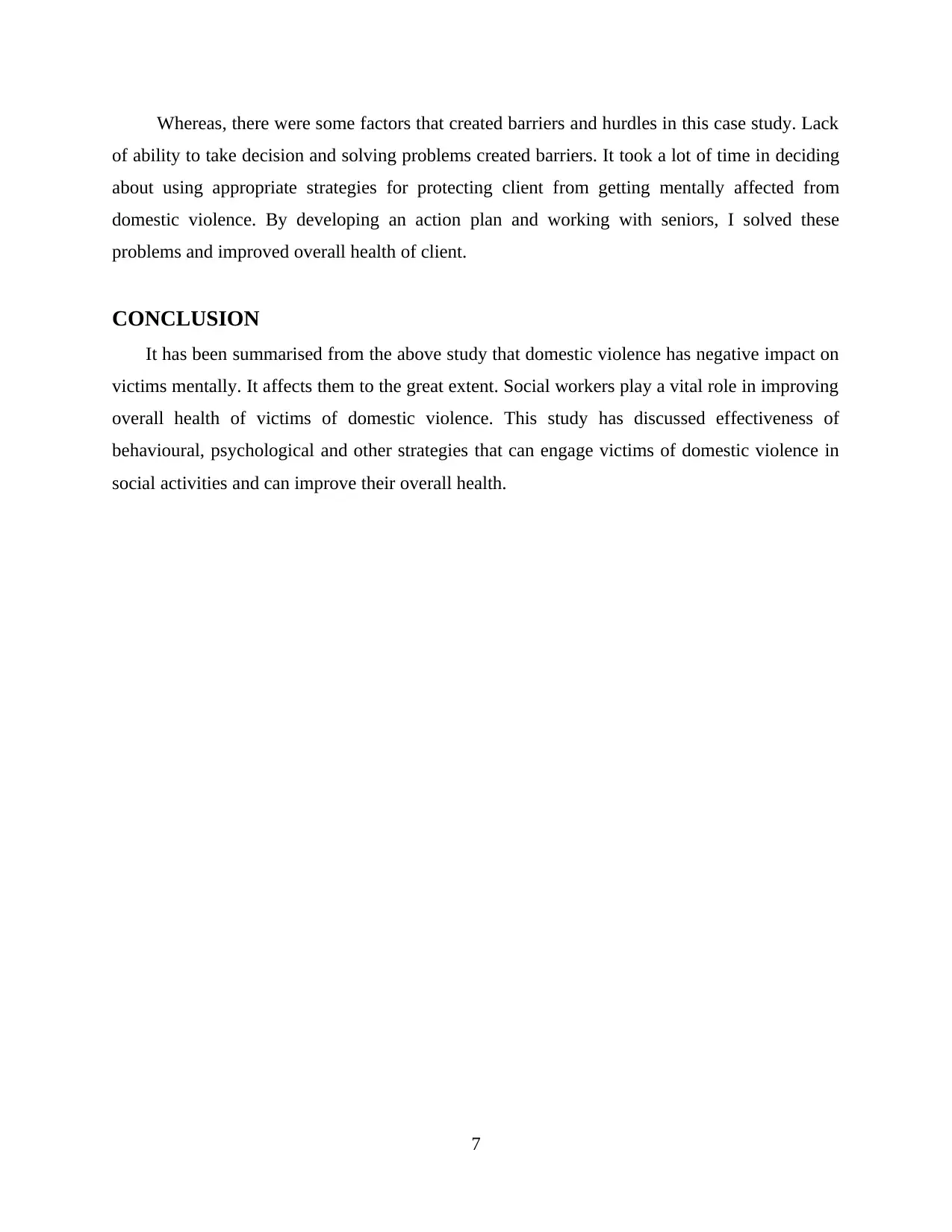
Whereas, there were some factors that created barriers and hurdles in this case study. Lack
of ability to take decision and solving problems created barriers. It took a lot of time in deciding
about using appropriate strategies for protecting client from getting mentally affected from
domestic violence. By developing an action plan and working with seniors, I solved these
problems and improved overall health of client.
CONCLUSION
It has been summarised from the above study that domestic violence has negative impact on
victims mentally. It affects them to the great extent. Social workers play a vital role in improving
overall health of victims of domestic violence. This study has discussed effectiveness of
behavioural, psychological and other strategies that can engage victims of domestic violence in
social activities and can improve their overall health.
7
of ability to take decision and solving problems created barriers. It took a lot of time in deciding
about using appropriate strategies for protecting client from getting mentally affected from
domestic violence. By developing an action plan and working with seniors, I solved these
problems and improved overall health of client.
CONCLUSION
It has been summarised from the above study that domestic violence has negative impact on
victims mentally. It affects them to the great extent. Social workers play a vital role in improving
overall health of victims of domestic violence. This study has discussed effectiveness of
behavioural, psychological and other strategies that can engage victims of domestic violence in
social activities and can improve their overall health.
7
Paraphrase This Document
Need a fresh take? Get an instant paraphrase of this document with our AI Paraphraser
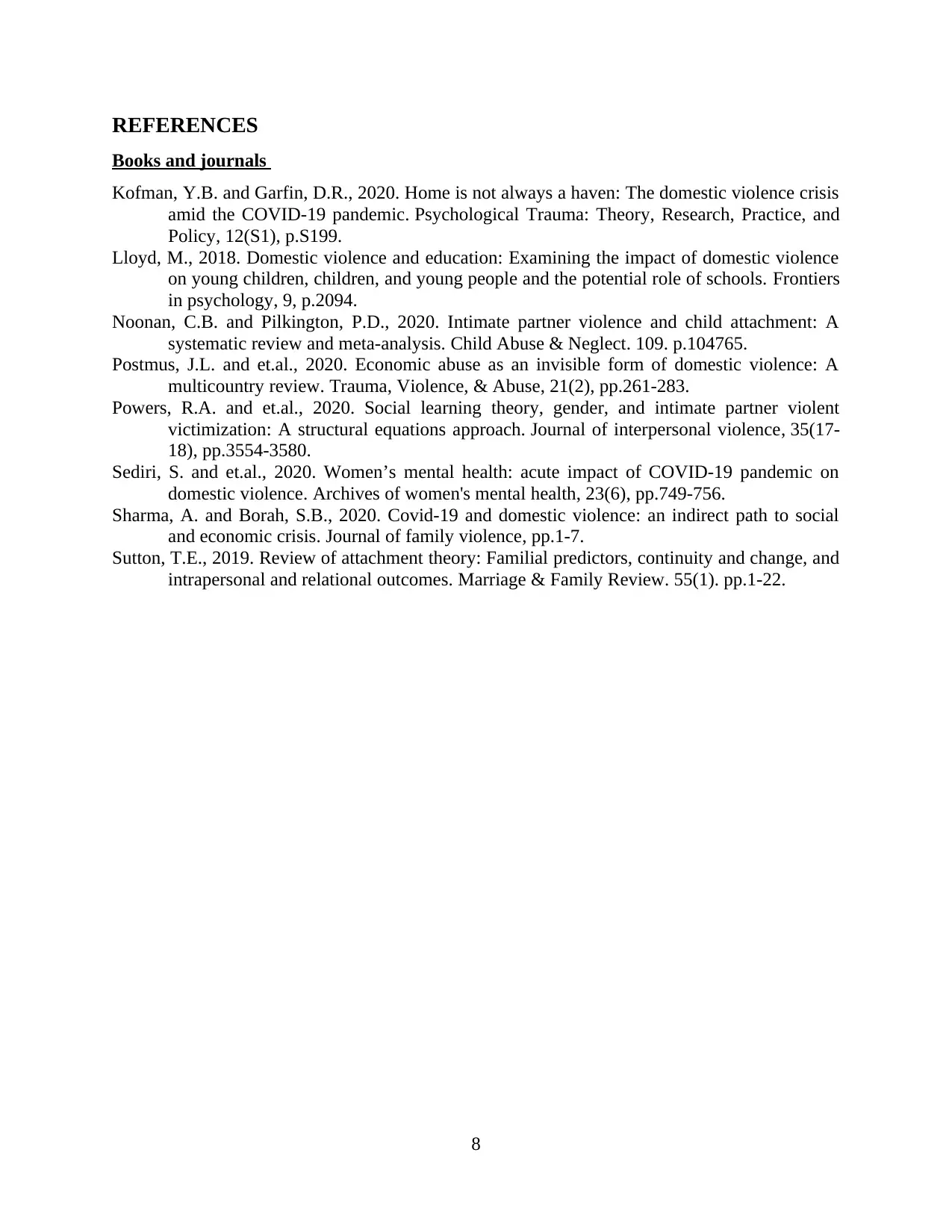
REFERENCES
Books and journals
Kofman, Y.B. and Garfin, D.R., 2020. Home is not always a haven: The domestic violence crisis
amid the COVID-19 pandemic. Psychological Trauma: Theory, Research, Practice, and
Policy, 12(S1), p.S199.
Lloyd, M., 2018. Domestic violence and education: Examining the impact of domestic violence
on young children, children, and young people and the potential role of schools. Frontiers
in psychology, 9, p.2094.
Noonan, C.B. and Pilkington, P.D., 2020. Intimate partner violence and child attachment: A
systematic review and meta-analysis. Child Abuse & Neglect. 109. p.104765.
Postmus, J.L. and et.al., 2020. Economic abuse as an invisible form of domestic violence: A
multicountry review. Trauma, Violence, & Abuse, 21(2), pp.261-283.
Powers, R.A. and et.al., 2020. Social learning theory, gender, and intimate partner violent
victimization: A structural equations approach. Journal of interpersonal violence, 35(17-
18), pp.3554-3580.
Sediri, S. and et.al., 2020. Women’s mental health: acute impact of COVID-19 pandemic on
domestic violence. Archives of women's mental health, 23(6), pp.749-756.
Sharma, A. and Borah, S.B., 2020. Covid-19 and domestic violence: an indirect path to social
and economic crisis. Journal of family violence, pp.1-7.
Sutton, T.E., 2019. Review of attachment theory: Familial predictors, continuity and change, and
intrapersonal and relational outcomes. Marriage & Family Review. 55(1). pp.1-22.
8
Books and journals
Kofman, Y.B. and Garfin, D.R., 2020. Home is not always a haven: The domestic violence crisis
amid the COVID-19 pandemic. Psychological Trauma: Theory, Research, Practice, and
Policy, 12(S1), p.S199.
Lloyd, M., 2018. Domestic violence and education: Examining the impact of domestic violence
on young children, children, and young people and the potential role of schools. Frontiers
in psychology, 9, p.2094.
Noonan, C.B. and Pilkington, P.D., 2020. Intimate partner violence and child attachment: A
systematic review and meta-analysis. Child Abuse & Neglect. 109. p.104765.
Postmus, J.L. and et.al., 2020. Economic abuse as an invisible form of domestic violence: A
multicountry review. Trauma, Violence, & Abuse, 21(2), pp.261-283.
Powers, R.A. and et.al., 2020. Social learning theory, gender, and intimate partner violent
victimization: A structural equations approach. Journal of interpersonal violence, 35(17-
18), pp.3554-3580.
Sediri, S. and et.al., 2020. Women’s mental health: acute impact of COVID-19 pandemic on
domestic violence. Archives of women's mental health, 23(6), pp.749-756.
Sharma, A. and Borah, S.B., 2020. Covid-19 and domestic violence: an indirect path to social
and economic crisis. Journal of family violence, pp.1-7.
Sutton, T.E., 2019. Review of attachment theory: Familial predictors, continuity and change, and
intrapersonal and relational outcomes. Marriage & Family Review. 55(1). pp.1-22.
8
1 out of 8
Related Documents
Your All-in-One AI-Powered Toolkit for Academic Success.
+13062052269
info@desklib.com
Available 24*7 on WhatsApp / Email
![[object Object]](/_next/static/media/star-bottom.7253800d.svg)
Unlock your academic potential
© 2024 | Zucol Services PVT LTD | All rights reserved.





